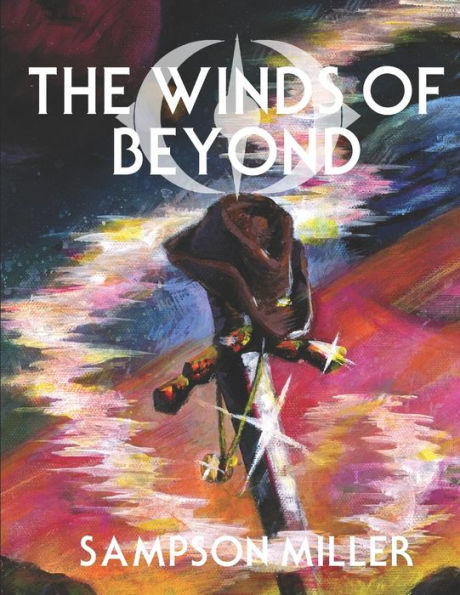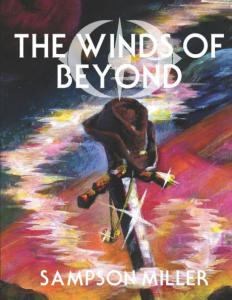

In his debut sci-fi release, The Winds of Beyond, author and BC student Sampson Miller immerses his readers into a MacGuffin tale where Earth is no more, and the galaxy of Serrellia harbors the only surviving terrestrial. What had originally started as doodles in Miller’s math book in high school has now become his first self-published book that plays with hero-villain dynamics, alien fantasy, and much more.
“Honestly, I always loved the idea of a last surviving human living in an alien galaxy and trying to find their way through that,” said Miller.
At only 21-years-old, Miller self-published his first book that came into fruition three years ago on his high school stage in his home state of California. Through his protagonist, Lyla Stone, a Jewish Brooklynite who becomes the last living Earthling, and King Drall, the extraterrestrial responsible for Earth’s destruction, Miller creates a story filled with adventure and complex understandings of humanity in a foreign galaxy. Both characters are in pursuit of the Winds of Beyond, a mythical treasure that has the ability to revive the dead or heal the ill.
Though an initial script laid the groundwork for this book, it underwent major revisions as Miller re-worked his characters with a matured writer’s lens. “The bones of the play are still in the book. And the broad strokes of the story are there, but a lot of the intricate details and even down to most of the characters are very different,” Miller said.
During his initial writing of The Winds of Beyond, Miller was a junior in high school going through some challenges and emotional distress which he believed reflected in his work. “In the play, my writing is all over the place, it’s very unfocused,” he said. Fast forward a few years later, moving from the West to East Coast, Miller tapped into his personal experiences to develop some of the characters to create a more well-rounded adventure.
“One of the things I incorporated from my personal life that you can definitely see through Lyla is that as a kid, I was always moving place to place,” Miller said. As Lyla enters the distinct, extraterrestrial galaxy of Serrellia, she leaves behind life on Earth as she knew it. Eventually, she’s forced to adapt to her new surroundings – something that Miller had picked up from his experiences starting most things anew.
“Being adaptive is something I think I’m good at and I think the way I adapt is definitely shown in Lyla’s character,” he said.
As he went on to develop her persona in the manuscript, he intended to make Lyla more well-rounded – with her goal becoming to find the Winds of Beyond that can resurrect her deceased mother.
Another character Miller developed was the leading antagonist King Drall, who rules over Serrellia and embodies tyrannical rule. To Miller, a villain is just as good as the accompanying hero. From his favorite classic adventures like Star Wars to Harry Potter, he wanted to make sure that both Lyla and Drall had more than just one stopping the other from interfering with their plans to obtaining the Winds of Beyond.
“He wants to study her because humanity itself is something that doesn’t exist in his galaxy,” Miller said when describing King Drall’s relationship with Lyla. “And vice versa, Lyla is interested in how someone can fall so far, and still hold onto some humanity.”
In exploring humanity, Miller brings up an array of topics that interconnect with the power struggles and relationships between his characters. As a political-science major at BC, he drew some references to different governing structures – King Drall representing tyrannical rule, who in turn overthrows the “facade of democracy” that is the Court of the Stars, Serrellia’s previous ruling body. Though he aimed to exclude his alien fantasy from “boring human politics,” it naturally became intertwined in the tale.
“Writing the book, I didn’t want to take one side of politics or the other, because I just sorted wanted this to be an absolute fantasy that anyone could enjoy regardless of their political views,” said Miller. “But of course, everything is political.”
In creating an extraterrestrial setting, with underlying components of humanity, Miller tasked himself with devising a new galaxy and its elements. Keeping it adventurous, and not at all scientifically accurate, he created planets like Tace, whose core and the atmosphere are made up of water. When it rains, it would do so upside down. “Again, scientifically it makes no sense, but it’s cool as hell,” said Miller.
Writing the book allowed Miller to develop his characters and imagery holistically, more than it was possible back in 2018 through its theatre adaptation. “With the book, I was so much more liberated. I was able to do so much more and I ended up doing that,” said Miller.
As Miller’s debut release garners its own momentum, he is preparing to release his sequel, The Last Terrestrial in 2022. There the adventures of Lyla will carry on.
